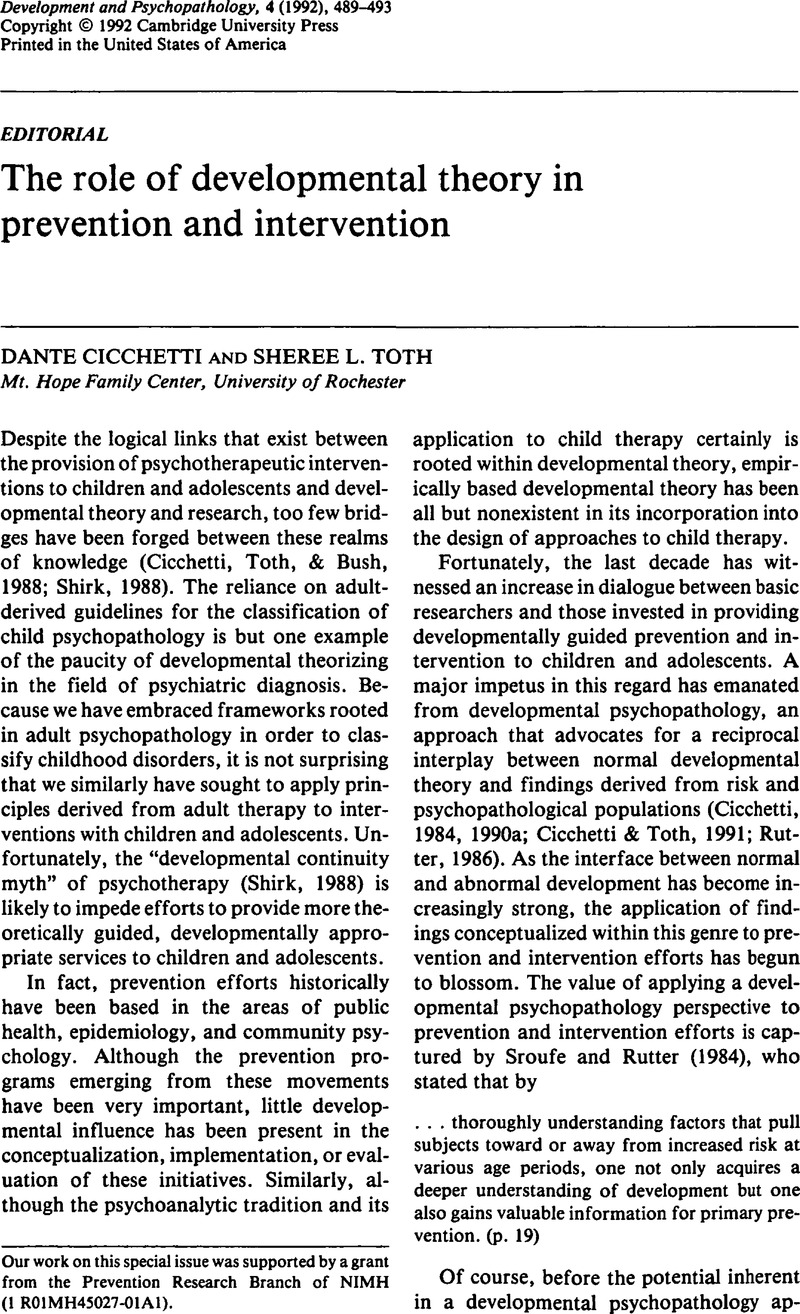Crossref Citations
This article has been cited by the following publications. This list is generated based on data provided by Crossref.
Stouthamer-Loeber, Magda
Loeber, Rolf
Farrington, David P.
Zhang, Quanwu
van Kammen, Welmoet
and
Maguin, Eugene
1993.
The double edge of protective and risk factors for delinquency: Interrelations and developmental patterns.
Development and Psychopathology,
Vol. 5,
Issue. 4,
p.
683.
Egeland, Byron
Carlson, Elizabeth
and
Sroufe, L. Alan
1993.
Resilience as process.
Development and Psychopathology,
Vol. 5,
Issue. 4,
p.
517.
Conrad, Marilyn
and
Hammen, Constance
1993.
Protective and resource factors in highand low-risk children: A comparison of children with unipolar, bipolar, medically ill, and normal mothers.
Development and Psychopathology,
Vol. 5,
Issue. 4,
p.
593.
Wyman, Peter A.
Cowen, Emory L.
Work, William C.
and
Kerley, Judy H.
1993.
The role of children's future expectations in self-system functioning and adjustment to life stress: A prospective study of urban at-risk children.
Development and Psychopathology,
Vol. 5,
Issue. 4,
p.
649.
Werner, Emmy E.
1993.
Risk, resilience, and recovery: Perspectives from the Kauai Longitudinal Study.
Development and Psychopathology,
Vol. 5,
Issue. 4,
p.
503.
Cicchetti, Dante
and
Rogosch, Fred A.
1994.
The Toll of Child Maltreatment on the Developing Child: Insights from Developmental Psychopathology.
Child and Adolescent Psychiatric Clinics of North America,
Vol. 3,
Issue. 4,
p.
759.
Speltz, Matthew L.
Greenberg, Mark T.
Endriga, Marya C.
and
Galbreath, Holly
1994.
Developmental Approach to the Psychology of Craniofacial Anomalies.
The Cleft Palate-Craniofacial Journal,
Vol. 31,
Issue. 1,
p.
61.
Dishion, Thomas J.
Capaldi, Deborah
Spracklen, Kathleen M.
and
Li, Fuzhong
1995.
Peer ecology of male adolescent drug use.
Development and Psychopathology,
Vol. 7,
Issue. 4,
p.
803.
Ryan, Virginia
and
Wilson, Kate
1995.
Non‐directive play therapy as a means of recreating optimal infant socialization patterns.
Early Development and Parenting,
Vol. 4,
Issue. 1,
p.
29.
Cicchetti, Dante
Toth, Sheree L.
and
Lynch, Michael
1995.
Advances in Clinical Child Psychology.
p.
1.
CICCHETTI, DANTE
and
TOTH, SHEREE L.
1995.
A Developmental Psychopathology Perspective on Child Abuse and Neglect.
Journal of the American Academy of Child & Adolescent Psychiatry,
Vol. 34,
Issue. 5,
p.
541.
Blechman, Elaine A.
1996.
Coping, competence, and aggression prevention: Part 2. Universal school-based prevention.
Applied and Preventive Psychology,
Vol. 5,
Issue. 1,
p.
19.
Raver, C. Cybele
1996.
Success at Catching and Keeping Toddler's Attention: An Examination of Joint Attention Among Low-Income Mothers and Their 2-Year-Olds.
Early Development and Parenting,
Vol. 5,
Issue. 4,
p.
225.
Raver, C.Cybele
and
Zigler, Edward F.
1997.
Social competence: An untapped dimension in evaluating head start's success.
Early Childhood Research Quarterly,
Vol. 12,
Issue. 4,
p.
363.
Cox, Martha J.
and
Paley, Blair
1997.
FAMILIES AS SYSTEMS.
Annual Review of Psychology,
Vol. 48,
Issue. 1,
p.
243.
Brandt, Patricia
and
Weinert, Clarann
1998.
Children's Mental Health in Families Experiencing Multiple Sclerosis.
Journal of Family Nursing,
Vol. 4,
Issue. 1,
p.
41.
Curran, Patrick J.
and
Muthén, Bengt O.
1999.
The Application of Latent Curve Analysis to Testing Developmental Theories in Intervention Research.
American Journal of Community Psychology,
Vol. 27,
Issue. 4,
p.
567.
Dishion, Thomas J.
and
Patterson, Gerald R.
1999.
Model Building in Developmental Psychopathology: A Pragmatic Approach to Understanding and Intervention.
Journal of Clinical Child Psychology,
Vol. 28,
Issue. 4,
p.
502.
Hughes, Jan N.
and
Cavell, Timothy A.
1999.
Handbook of Psychotherapies with Children and Families.
p.
419.
Toth, Sheree L.
and
Cicchetti, Dante
1999.
Handbook of Psychotherapies with Children and Families.
p.
15.





